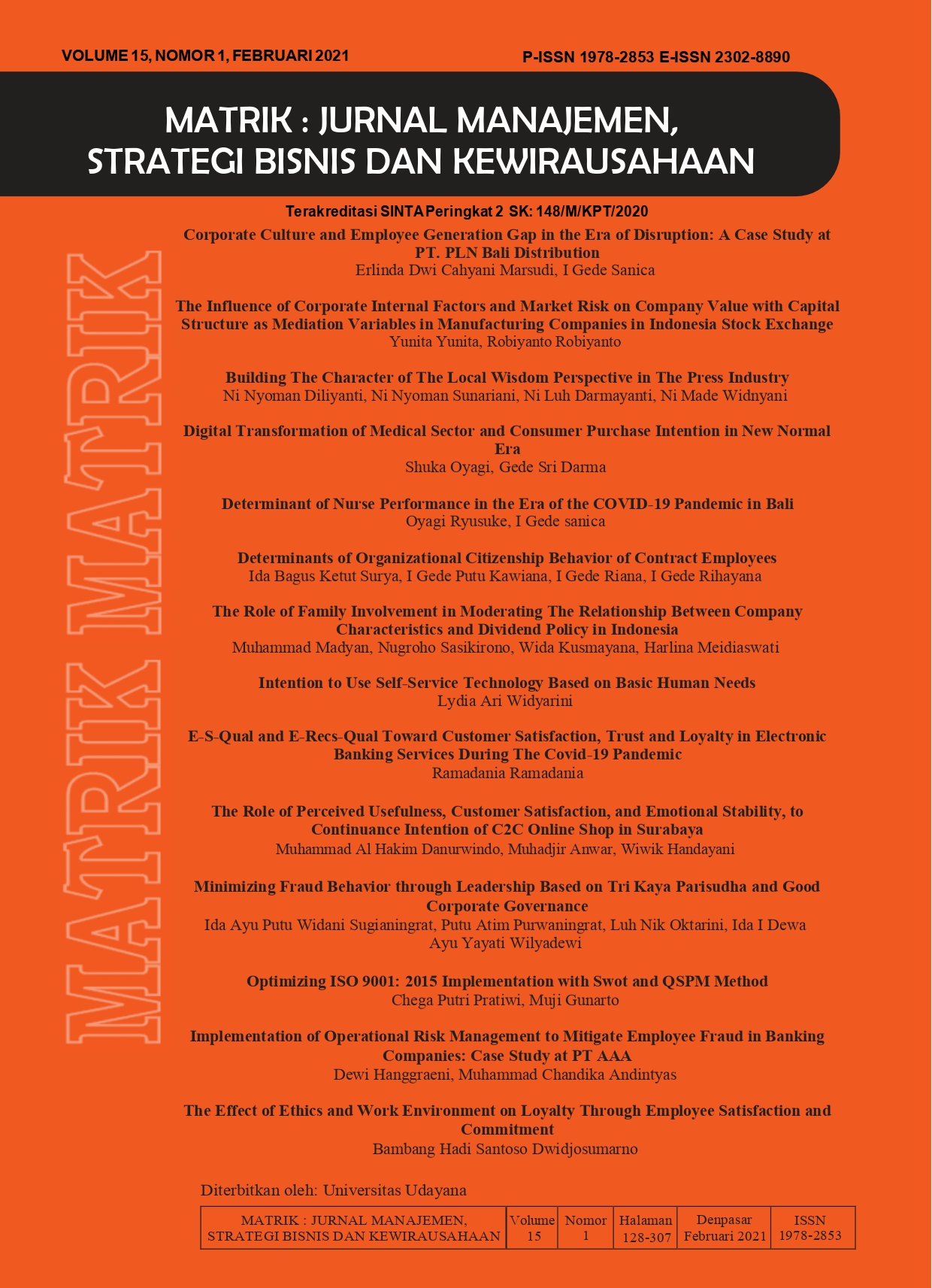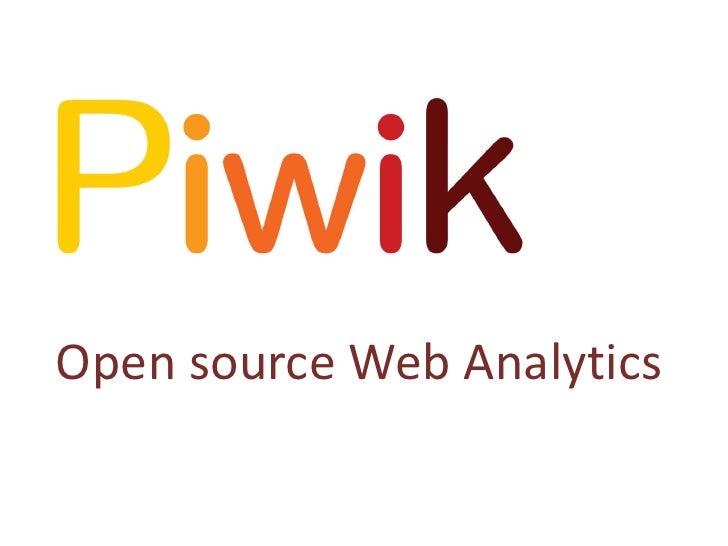Digital Transformation of Medical Sector and Consumer Purchase Intention in New Normal Era
Abstract
New Normal era triggers a shift in consumer habit and behavior, such as increased awareness regarding the importance of health and sanitation, as well as elevated adoption of digital technology in daily activities. This study explored digital transformation aspects that impact consumer purchase intention in New Normal era, specifically in healthcare setting. An online-based quistionnaire were distributed using Google Form. A total of 225 response were retrieved and analysed using SEM technique (SmartPLS 3.2.1.). This study found that: 1) social media content quality, online customer service quality, and telehealth quality had a positive and significant impact to purchase intention; 2) telehealth quality had the most prominent impact on purchase intention, especially the support aspect; 3) website quality did not have any significant effect on consumer purchase intention. In conclusion, companies are recommended to focus on improving telehealth quality in their healthcare management system, especially by investing in reliable technical support staff to ensure assuring and pleasant experience for patients during telehealth sessions. Also, to focus more on social media content quality and online customer service quality than website refinement considering the current elevating trend on social media rahter than website.
Downloads
References
Agrawal, G., Kumar, D., Singh, M., & Dani, D. (2019). Evaluating accessibility and usability of airline websites. In Communications in Computer and Information Science (Vol. 1045). Springer Singapore. https://doi.org/10.1007/978-981-13-9939-8_35
Agus Widarjono. (2015). Analisis Multivariate Terapan Dengan Program SPSS, AMOS, dan SmartPLS (2nd ed.). UPP STIM YKPN.
Alekseeva, N., Stroganova, O., & Vasilenok, V. (2019). Identifying trends in the development of marketing in the digital age. 1(Icdtli), 13–16. https://doi.org/10.2991/icdtli-19.2019.4
Analisis data Covid-19 Indonesia. (2020, October 4). Satuan Tugas Penanganan Covid-19.
Andriani, H. (2020). Effectiveness of Large-Scale Social Restrictions (PSBB) toward the New Normal Era during COVID-19 Outbreak: a Mini Policy Review. Journal of Indonesian Health Policy and Administration, 5(2), 61–65. https://doi.org/10.7454/ihpa.v5i2.4001
Arli, D. (2017). Does Social Media Matter? Investigating the Effect of Social Media Features on Consumer Attitudes. Journal of Promotion Management, 23(4), 521–539. https://doi.org/10.1080/10496491.2017.1297974
Barnes, S. J. (2020). Information management research and practice in the post-COVID-19 world. International Journal of Information Management, June, 102175. https://doi.org/10.1016/j.ijinfomgt.2020.102175
Bounie, D., Camara, Y., & Galbraith, J. W. (2020). Consumers’ Mobility, Expenditure and Online-Offline Substitution Response to COVID-19: Evidence from French Transaction Data. SSRN Electronic Journal. https://doi.org/10.2139/ssrn.3588373
Chang, H.-H., & Meyerhoefer, C. (2020). COVID-19 and the Demand for Online Food Shopping Services: Empirical Evidence from Taiwan. In NBER Working Paper No. 27427. https://doi.org/10.3386/w27427
Chawla, S. P. D. (2014). Using qualitative research for establishing content validity of e-lifestyle and website quality constructs. Qualitative Market Research: An International Journal, 19(3).
Chicu, D., Pàmies, M. del M., Ryan, G., & Cross, C. (2019). Exploring the influence of the human factor on customer satisfaction in call centres. BRQ Business Research Quarterly, 22(2), 83–95. https://doi.org/10.1016/j.brq.2018.08.004
Durai, T., & King, R. (2019). Impact of Digital Marketing on the Growth of Consumerism. https://doi.org/https://dx.doi.org/10.2139/ssrn.3344421
Elisa, R., & Gordini, N. (2014). Content Marketing Metrics: Theoretical Aspects and Empirical Evidence. European Scientific Journal, 10(34), 1857–7881.
Famiyeh, S., Asante-Darko, D., & Kwarteng, A. (2018). Service quality, customer satisfaction, and loyalty in the banking sector. International Journal of Quality & Reliability Management, 35(8), 1546–1567. https://doi.org/10.1108/ijqrm-01-2017-0008
Ferdinand, A. T. (2014). Metode Penelitian Manajemen. Badan Penerbit Universitas Diponegoro.
Garett, R., Chiu, J., Young D, S., & Zhang, L. (2016). A Literature Review: Website Design and User Engagement. Online J Commun Media Technol, 6(3)(July), 1–14.
Geng, R., Wang, S., Chen, X., Song, D., & Yu, J. (2020). Content marketing in e-commerce platforms in the internet celebrity economy. Industrial Management and Data Systems, 120(3), 464–485. https://doi.org/10.1108/IMDS-05-2019-0270
Ghozali, & Latan. (2015). Partial Least Squares, Konsep Teknik dan Aplikasi Menggunakan Program SmartPLS 3.0 (2nd ed.). Badan Penerbit Universitas Diponegoro.
Godovykh, M., & Tasci, A. D. A. (2020). Customer experience in tourism: A review of definitions, components, and measurements. Tourism Management Perspectives, 35(May), 100694. https://doi.org/10.1016/j.tmp.2020.100694
Gumus, N. (2017). The effects of social media content marketing activities of firms on consumers’ brand following behavior. Academic Research International, 8(1).
Haryono, S. (2017). Metode SEM Untuk Penelitian Manajemen dengan AMOS Lisrel PLS (1st ed.). Luxima Metro Media.
Hussain, R., & Ali, M. (2018). Effect of Store Atmosphere on Consumer Purchase Intention. SSRN Electronic Journal, 73. https://doi.org/10.2139/ssrn.2588411
Hussein, A. (2015). Penelitian Bisnis dan Manajemen Menggunakan Partial Least Squares (PLS) dengan SmartPLS 3.0. Universitas Brawijaya.
Kan, M. P. H., Fabrigar, L. R., & Fishbein, M. (2017). Theory of Planned Behavior. In V. Zeigler-Hill & T. K. Shackelford (Eds.), Encyclopedia of Personality and Individual Differences. Springer International Publishing. https://doi.org/10.1007/978-3-319-28099-8_1191-1
Khatoon, S., Zhengliang, X., & Hussain, H. (2020). The Mediating Effect of Customer Satisfaction on the Relationship Between Electronic Banking Service Quality and Customer Purchase Intention: Evidence From the Qatar Banking Sector. SAGE Open, 10(2). https://doi.org/10.1177/2158244020935887
Kim, R. Y. (2020). The Impact of COVID-19 on Consumers: Preparing for Digital Sales. IEEE Engineering Management Review. https://doi.org/10.1109/EMR.2020.2990115
Konstantopoulou, A., Rizomyliotis, I., Konstantoulaki, K., & Badahdah, R. (2019). Improving SMEs’ competitiveness with the use of Instagram influencer advertising and eWOM. International Journal of Organizational Analysis, 27(2), 308–321. https://doi.org/10.1108/IJOA-04-2018-1406
Kotane, I., Znotina, D., & Hushko, S. (2019). ASSESSMENT OF TRENDS IN THE APPLICATION OF DIGITAL MARKETING. Periodyk Naukowy Akademii Polonijnej, 32(1), 26–37. https://doi.org/http://dx.doi.org/10.23856/3303
Küster, I., Vila, N., & Canales, P. (2016). How does the online service level influence consumers’ purchase intentions before a transaction? A formative approach. European Journal of Management and Business Economics, 25(3), 111–120. https://doi.org/10.1016/j.redeen.2016.04.001
Lewnard, J. A., & Lo, N. C. (2020). Scientific and ethical basis for social-distancing interventions against COVID-19. The Lancet. https://doi.org/https://doi.org/10.1016/ S1473?3099(20)30190?0
Li, K. J., & Li, X. (2020). COVID-19 Pandemic: Social Distancing, Public Policy, and Market Response. Social Science Research Network. https://doi.org/https://dx.doi.org/10.2139/ssrn.3593813
Liu, N., Huang, R., Baldacchino, T., Sud, A., Sud, K., Khadra, M., & Kim, J. (2020). Telehealth for noncritical patients with chronic diseases during the COVID-19 pandemic. Journal of Medical Internet Research, 22(8), 8–11. https://doi.org/10.2196/19493
Liu, W. K., Lee, Y. S., & Hung, L. M. (2017). The interrelationships among service quality, customer satisfaction, and customer loyalty: Examination of the fast-food industry. Journal of Foodservice Business Research, 20(2), 146–162. https://doi.org/10.1080/15378020.2016.1201644
Liu, Y., Segev, S., & Villar, M. E. (2017). Comparing two mechanisms for green consumption: cognitive-affect behavior vs. theory of reasoned action. Journal of Consumer Marketing. https://doi.org/Permanehttps://doi.org/10.1108/JCM-01-2016-1688
Marques, I. C. P., & Ferreira, J. J. M. (2020). Digital transformation in the area of health: systematic review of 45 years of evolution. Health and Technology, 10(3), 575–586. https://doi.org/10.1007/s12553-019-00402-8
Mi, C., Chang, F. K., Lin, C. T., & Chang, Y. H. (2018). The theory of reasoned action to CSR behavioral intentions: The role of CSR expected benefit, CSR expected effort and stakeholders. Sustainability (Switzerland), 10(12), 1–17. https://doi.org/10.3390/su10124462
Minh, N. V., & Huu, N. H. (2016). The Relationship between Service Quality, Customer Satisfaction and Customer Loyalty: An Investigation in Vietnamese Retail Banking Sector. Journal of Competitiveness, 8(2), 103–116. https://doi.org/10.7441/joc.2016.02.08
Mohd Paiz, N. A., Hareeza Ali, M., Rashid Abdullah, A., & Dato Mansor, Z. (2020). The Effects of Service Quality on Satisfaction and Purchase Intention in Mobile Commerce. International Journal of Business and Management, 15(4), 36. https://doi.org/10.5539/ijbm.v15n4p36
Müller, J., & Christandl, F. (2019). Content is king – But who is the king of kings? The effect of content marketing, sponsored content & user-generated content on brand responses. Computers in Human Behavior, 96(November 2018), 46–55. https://doi.org/10.1016/j.chb.2019.02.006
Novara, G., Checcucci, E., Crestani, A., Abrate, A., Esperto, F., Pavan, N., De Nunzio, C., Galfano, A., Giannarini, G., Gregori, A., Liguori, G., Bartoletti, R., Porpiglia, F., Scarpa, R. M., Simonato, A., Trombetta, C., Tubaro, A., & Ficarra, V. (2020). Telehealth in Urology: A Systematic Review of the Literature. How Much Can Telemedicine Be Useful During and After the COVID-19 Pandemic? European Urology. https://doi.org/10.1016/j.eururo.2020.06.025
Otieno, O. C., Liyala, S., Odongo, B. C., & Abeka, S. (2016). Theory of Reasoned Action as an Underpinning to Technological Innovation Adoption Studies. World Journal of Computer Application and Technology, 4(1), 1–7. https://doi.org/10.13189/wjcat.2016.040101
Parodi, S., Choucair, B., Young, S., Bellows, J., Grossman, D., & Liu, V. X. (2020). Kaiser Permanente’s System Capabilities to Suppress Covid-19 | Catalyst non-issue content. New England Journal of Medicine. https://doi.org/10.1056/CAT.20.0187
Pham, V. K., Nguyen, T. Le, Do, T. T. H., Tang, M. H., & Thu Hoai, H. Le. (2020). A Study on Switching Behavior Toward Online Shopping of Vietnamese Consumer During the Covid-19 Time. SSRN Electronic Journal. https://doi.org/10.2139/ssrn.3651300
Priyatno, D. (2013). Mandiri Belajar Analisis Data Dengan SPSS. Media Kom.
Ray Dorsey, E., & Topol, E. J. (2016). State of telehealth. New England Journal of Medicine, 375(2), 154–161. https://doi.org/10.1056/NEJMra1601705
Reeves, M., Carlsson-Szlezak, P., Whitaker, K., & Abraham, M. (2020). Sensing and Shaping the Post-COVID Era. Bcg, 1–9. https://bcghendersoninstitute.com/sensing-and-shaping-the-post-covid-era-c282cd227a4f
Seyyedamiri, N., & Tajrobehkar, L. (2019). Social content marketing, social media and product development process effectiveness in high-tech companies. International Journal of Emerging Markets. https://doi.org/10.1108/IJOEM-06-2018-0323
Sheth, J. (2020). Impact of Covid-19 on consumer behavior: Will the old habits return or die? Journal of Business Research, 117, 280–283. https://doi.org/10.1016/j.jbusres.2020.05.059
Smith, A. C., Thomas, E., Snoswell, C. L., Haydon, H., Mehrotra, A., Clemensen, J., & Caffery, L. J. (2020). Telehealth for global emergencies: Implications for coronavirus disease 2019 (COVID-19). Journal of Telemedicine and Telecare, 26(5), 309–313. https://doi.org/10.1177/1357633X20916567
Spiegelman, J., Krenitsky, N., Syeda, S., Sutton, D., & Moroz, L. (2020). Implementation of a Covid-19. https://doi.org/10.1056/CAT.20.0170
Statista. (2020). Average time spent using online media in Indonesia in Q3 2019, by activity.
Suarna, N. (2020, August 14). Anggaran Penanggulangan Covid-19 Rp 756 M, Terserap 100 Persen. Jawa Pos Bali. https://baliexpress.jawapos.com/read/2020/08/14/209139/anggaran-penanggulangan-covid-19-rp-756-m-terserap-100-persen
Suryono, A. (2020). Teori dan Strategi Perubahan Sosial. PT.Bumi Aksara.
Syrdal, H. A., & Briggs, E. (2018). Engagement With Social Media Content: a Qualitative Exploration. Journal of Marketing Theory and Practice, 26(1–2), 4–22. https://doi.org/10.1080/10696679.2017.1389243
Vinerean, S. (2017). Importance of Strategic Social Media Marketing. Expert Journal of Marketing, 5(1), 28–35.
Vogler, S. A., & Lightner, A. L. (2020). Rethinking how we care for our patients in a time of social distancing during the COVID-19 pandemic. British Journal of Surgery, 107(8), 937–939. https://doi.org/10.1002/bjs.11636
We Are Social & Hootsuite. (2019). Digital 2019. In We Are Social & Hootsuite. https://es.slideshare.net/DataReportal/digital-2019-argentina-january-2019-v01?from_action=save
Weerasinghe, K. D. R. (2018). Impact of content marketing towards the customer online engagement. International Journal of Research in Business, Economics, and Management, 2(3).
WHO Indonesia. (2020, March 8). Media Statement: Knowing the risks for COVID-19. World Health Organization. https://www.who.int/indonesia/news/detail/08-03-2020-knowing-the-risk-for-covid-19
Wijesooriya, N. R., Mishra, V., Brand, P. L. P., & Rubin, B. K. (2020). COVID-19 and telehealth, education, and research adaptations. Paediatric Respiratory Reviews, 35, 38–42. https://doi.org/10.1016/j.prrv.2020.06.009
Wilder-Smith, A., & Freedman, D. O. (2020). Isolation, quarantine, social distancing and community containment: Pivotal role for old-style public health measures in the novel coronavirus (2019-nCoV) outbreak. Journal of Travel Medicine, 27(2), 1–4. https://doi.org/10.1093/jtm/taaa020
Wosik, J., Fudim, M., Cameron, B., Gellad, Z. F., Cho, A., Phinney, D., Curtis, S., Roman, M., Poon, E. G., Ferranti, J., Katz, J. N., & Tcheng, J. (2020). Telehealth transformation: COVID-19 and the rise of virtual care. Journal of the American Medical Informatics Association, 27(6), 957–962. https://doi.org/10.1093/jamia/ocaa067
Zwanka, R. J., & Buff, C. (2020). COVID-19 Generation: A Conceptual Framework of the Consumer Behavioral Shifts to Be Caused by the COVID-19 Pandemic. Journal of International Consumer Marketing, 0(0), 1–10. https://doi.org/10.1080/08961530.2020.1771646
 This work is licensed under a Creative Commons Attribution-ShareAlike 4.0 International License.
This work is licensed under a Creative Commons Attribution-ShareAlike 4.0 International License.

















